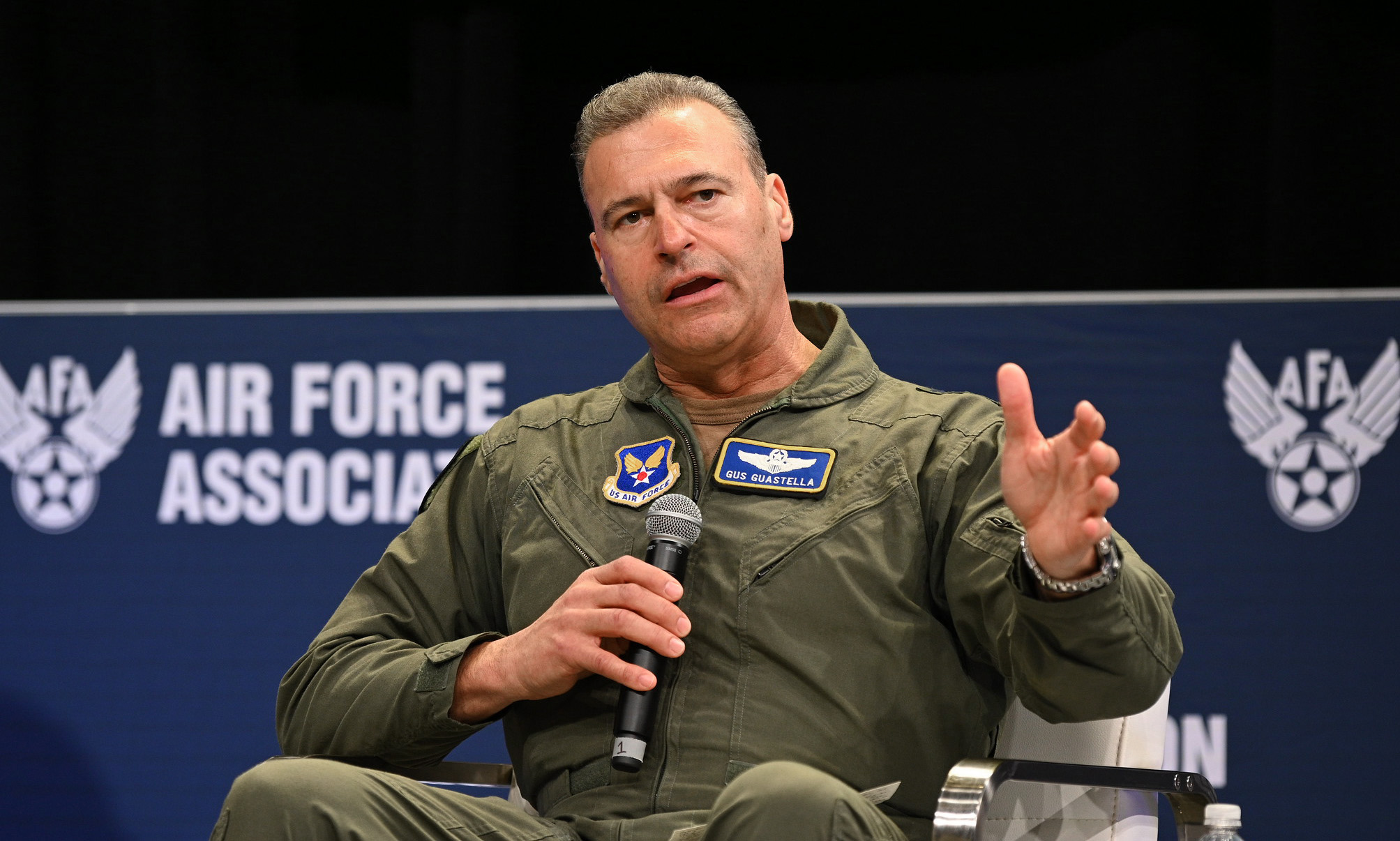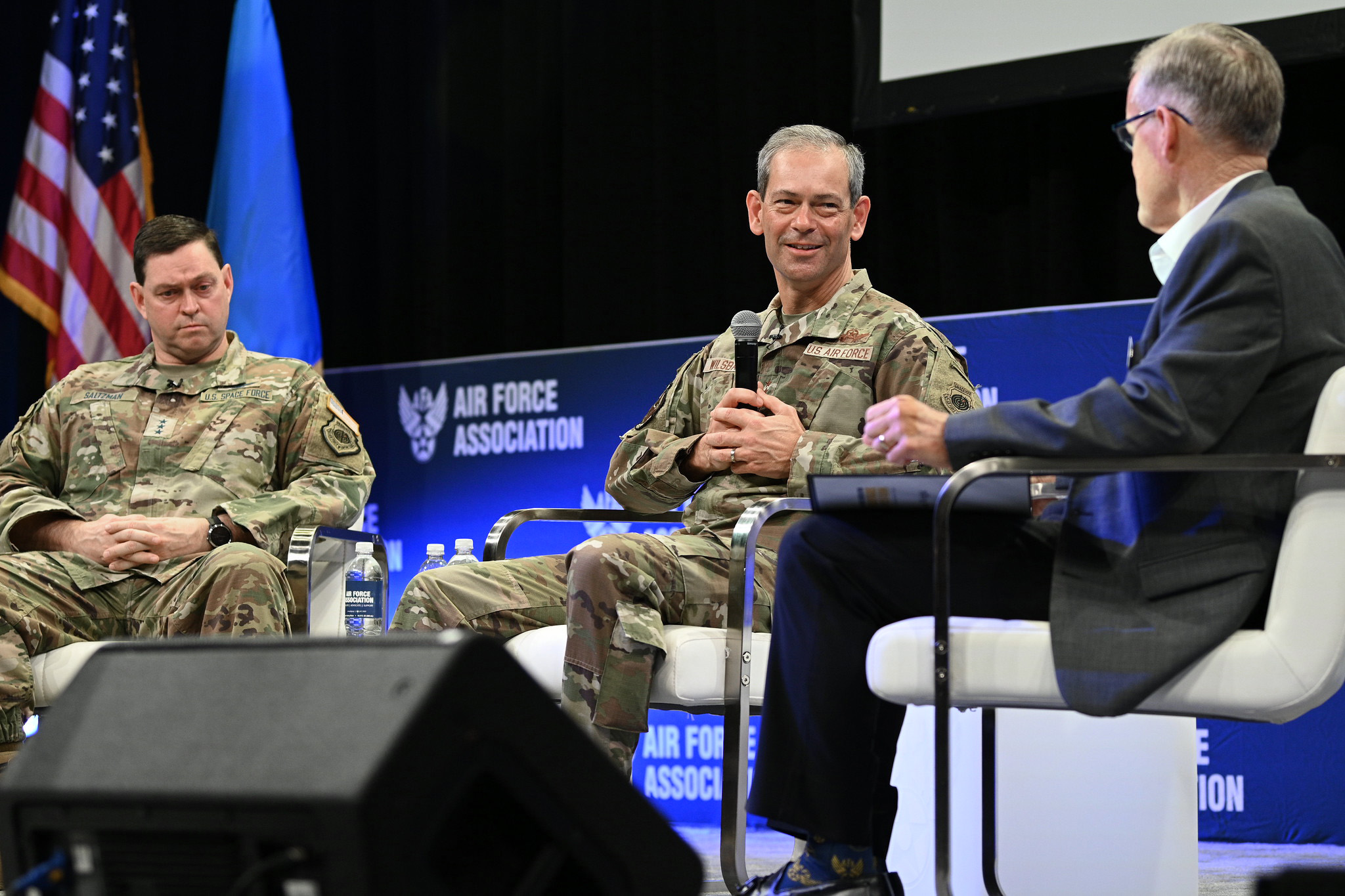Brig. Gen. Jeffery Valenzia, Department of the Air Force Advance Battle Management System Cross Functional Team Lead, moderates a discussion on joint all-domain command and control with Ron Fehlen, vice president and general manager of Air Force Programs, Broadband Communications Systems, L3Harris Technologies; James Dorrell, vice president of ABMS of Lockheed Martin; Lanny Merkel, director of JADC2 Capabilities Mission Systems at Collins Aerospace during the AFA Warfare Symposium on March 3, 2022. Watch the video or read the transcript below. This transcript is made possible through the sponsorship of JobsOhio.
Brig. Gen. Jeffery Valenzia, Department of the Air Force Advance Battle Management System Cross Functional Team Lead: Good afternoon, I’m Jeff Valenzia. I, in partnership with Brig. Gen. John Olson, who was the lead from Space Force and the rapid capabilities office in the lead of Mr. Walden, are responsible for the modernization of Advanced Battle Management Systems. And so we’re going to talk to you a bit today just about where we are in that conversation of modernizing what we call command, and what we call battle management. And we have a really esteemed panel here of experts from industry, they’re going to talk about the incredibly close partnership that we have as the warfighters with industry. If we’re going to bring this reality of changing the way we sense, make sense and act and put it into your hands as a warfighter—out of curiosity, how many in this room here are battle managers? OK, a couple—I will tell you that the system of which we are designing, what is absolutely essential in this system, and our success, is the role of the battle manager.
Let me just put down this: we are not computerizing battle management, we are not taking the sophisticated functions that sit in the hands of the profession of our battle managers, and writing them into an algorithm. In fact, battle management is essential that we have the man in the loop and part of that process, to take the data, the information, turn it into knowledge and direct the actions if we’re going to win. The imperatives of how we do that, however, have changed. If you take a look at our battle management processes today, and I’m not going to surprise any of you when I tell you, that’s way too slow. I’m not going to surprise any of you when I tell you it’s way too vulnerable. And I’m not going to surprise any of you, when I tell you, not only just within the Air and Space Force, but across the entirety of the joint force, it’s way too stovepipe. And if we’re going to modernize, the way in which we make decisions, and the way in which we direct actions is going to have to get at the core of these foundational challenges that we have. And to do that, we have to put a stake in the ground in what we call our theory of victory. And our theory of victory is this. We believe that if you’re going to succeed against an advanced adversary, as essential as the bombs, bullets and platforms of which we know and have come to rely on in war is going to be how you sense, make sense and act in your environment.
And to do that, we’re going to have to make the functions of command and the functions of control separable. I did not say separated, separable. That does not mean that I need a commander inside the loop of every decision once they’ve allocated the resources and authorities and provided the intent. I don’t need them calling every shot in execution, I need them to hand it over to a control node that has the tools and the ability to direct that action to meet that intent. It has to happen in a matter of microseconds in some cases. But that’s not going to be the case in all of our missions. For instance, I’m not going to separate control from command when it comes to nuclear operations. Instead, we have to design a system that has the ability to accommodate based upon the tactical scenario, and the risk — how we can separate those two—and it’s a lot harder than we initially thought. Second, we’ve got to go from our model of coupled battle management into a decoupled and distributed model of battle management. That means I can’t expect if I’m going to affect an outcome on the tactical edge, that I have to put the battle manager, their information systems, their sensors, and their direct communication into one platform and fly it where it becomes a missile magnet. We’ve got to be able to decouple those and decouple those in a very smart, methodical way. And it begins with the notion that they shouldn’t have to sit under or on top of their sensor to be effective. Rather, we’ve got to be able to deliver the information they need to be effective from distributed sensors, through sophisticated but very effective fusion models. I also can’t put them in reliance that they’re sitting in direct comms with every single platform which they control. The tyranny of distance, or the tyranny of speed, depending upon what you want to drive and what AOR you’re talking about, has put us into a position that conventional communication networks are no longer survivable or effective.
Finally, I have to integrate them. I have to integrate their processes, I have to drive commonality amongst the way in which we plan, allocate resources, measure and account for risk. But we also have to create commonality in their systems. And this drives a horizontal-vertical integration in our designs that we have both within the Air and the Space Force, but also across the joint force in a new and novel way. But I’m gonna go back to what I started with. Absolutely essential is there will be battle managers involved in this system. And we’re going to design it into the system in a way in which we’re to give them the applications to interface with the information, they have to transition that into knowledge. And then they can direct the action. But we’re also going to write some algorithms. So let’s not kid ourselves, there are some processes of which we relied on people, manpower, to do that we don’t anymore. And that we have a sophisticated enough understanding of those functions and those tasks and those processes to be successful, that we’re able to start to parse out some mundane, or error-prone tasks. And we’re able to allocate those to some machine activities. And what I’m painting for you is a picture where battle management achieves the same outcome of which it always has sought to achieve, but the manner in which we achieve that outcome, how we pull together, the technologies, how we mature, our tactics, techniques and procedures is changed. And it’s changing now. And so with that, just to set the course here, I want to give this panel an opportunity introduce themselves. And I’d love to have a conversation with how industry is going to be a part of what is ostensibly a really difficult task in front of us. So Ron, I’ll start with you.
Ron Fehlen, vice president and general manager of Broadband Communications Systems at L3Harris Technologies: So hey, thanks for the intro. Ron Fehlen, I’m the vice president and general manager for broadband communication system at L3Harris Technologies out in Salt Lake City, I tell you, when I listened to you talk about the networks, I immediately go back to what our core capabilities are, to ensure that we have a secure, assured resilient network to be able to push that data around to get to where it needs to be to feed all those algorithms, first of all. But I will tell you, as well, as I listen, I think back to my military career after 20 years, and the first part of it, as I mentioned previously, was spent on AWACS, and got to ride in the back end on the mission crew for about seven years. And I couldn’t agree with you more that the human part of the battle manager and that is so critical to the decisions, life and death decisions that are made every day. And I got to witness that firsthand.
And I’ll share as well, we never at that time, this was the ’90s timeframe, watching no fly zones and things of that nature. Never at that time did we talk about space, never talked about yet. You just talked about the fact that you’re not the only one that’s advocating here. It’s the Air Force and the Space Force working together. And then the third part is the joint force. While we always had the joint force, the level of integration, I think going forward, as you mentioned, is going to be actually absolutely critical going forward. So as a matter of intro, at least, and I’ll pass it on, Lanny.
Lanny Merkel, director of JADC2 Capabilities Mission Systems at Collins Aerospace: All right, thanks. So Lanny Merkel, I’m the director of JADC2 capabilities for Collins Aerospace, based in Cedar Rapids, Iowa. Unlike the other two members of the panel here, I never did serve. My background is in engineering, actually. Right. So I resonate a lot with some of the comments that the General made, right.
And sometimes, as engineers, right, we think of capabilities and delivering capabilities. And we also need to consider the operational constraints and context of, you know, engineers want to give you all the data and put it on all every inch of every display. And one of the challenges that we really need to get through is what data do we need to move around for operational benefit for the warfighter, right? And how do we reduce the amount of information that you need to go through so that you can really accurately make the decisions that you need to make as battle managers. And like Ron said, we know that that’s underpinned by having these resilient networks that allow us to move data and information around, secure processing so it’s always available. But ultimately, it does come down to the battle manager to make those effective decisions.
James Dorrell, vice president of ABMS of Lockheed Martin: Thanks, guys. Good afternoon, James Dorrell, Lockheed Martin. I’m the Vice President of ABMS and we’re trying to put a finer point on that within our corporation. Along with my esteemed industry panelists here, I just want to thank AFA, first of all, for giving us this platform to talk about a real critical, critical topic. I’m so excited to be face to face and not on a Zoom call. That by itself is, has been worth its weight this week. But just a couple of quick thoughts and when we can get back to Spaniard and maybe have some more robust discussion. I think we do have, as an Air Force, some foundational building blocks to that are important to ABMS. We have survivable platforms; we have many today and more coming in the near future. Those platforms have very capable sensors, which are going to provide that that plethora of data that we have. We have, you know, open system architecture technologies, that the RCO has played a vital part of the last decade in maturing, I think that’s an important building block. And then we have ground stations like the Shadow Ops Center at Nellis and common mission control center.
But even all those foundational building blocks, the drawback is they’re not tightly integrated. They’re not integrated horizontally, vertically. Many times, they’re in a single domain construct. And they’re very capable within that single domain construct. But that’s not what we need going forward. So just to kind of echo Ron and Lanny, what we need, resilient networks, absolutely. Multipath, self-healing that the network has got to be able to sense when it is under threat, under fire and be able to direct multiple paths. The data, I think Lanny talked about the data in many ways. ABMS is all about the data. And that data on those platforms is coming in at multiple security levels. And the network and the data managers have got to be able to condense that down to a common security framework to pass it ubiquitously. And then the third part I would say is, we’ve got to have a common set of standards and architectures and ones that are non-proprietary. That has proved extremely beneficial in the past. The UCI consortium that the RCO did, I think it’s a model we can use, but we got to be able to have, easily, third party applications move the data on resilient networks in some common standards. So let me stop there and pass it back to Spaniard.
Valenzia: Now, thanks. So recency has its primacy. So James, I’m going to pick on what you just said there. I’m an operator. And so a lot of the language that you use there doesn’t translate well into the operational construct. And I’d be interested to go a little bit deeper, because the imperative that you’re driving towards is interoperability. The approach that you’re driving towards interoperability is this idea of open mission system architecture. I don’t really know exactly what that means. And I bet you there are probably others. Could you maybe talk a little bit about from an industry perspective, what does that really mean? And how does that translate into the systems that you deliver? And so you guys are off the hook because I’m going to springboard to each of you to see how you think about that, because I’m gonna add another hook into it. There’s what we build, and what we have, and some of what we have, we inherited.
Dorrell: So let me give you an analogy here that hopefully resonates with some people. What is a closed architecture, maybe if we start there, then it’s easier to define open architecture. A closed architecture is one in which an industry member has vendor lock. And every time there is an upgrade, or an update that the Air Force needs or wants, they have to come back to that industry partner, and pay us over and over to update that closed architecture. That is absolutely what we don’t want. If all of industry is designing these resilient networks, and designing these algorithms that Spaniard talked about to a common set of standards and architectures, then every industry partner is bringing the best of breed to the table. And we can easily affordably integrate those apps or kinetic capabilities, non-kinetic capabilities in that open architecture rapidly, affordably and get capability in the warfighters’ hands more quickly. I don’t know if Ron or Lanny want to add on to any of that.
Merkel: Yeah, I mean, I agree. I think I view open architectures as kind of table stakes, if you’re going to participate in this type of industry going forward. And like James mentioned there, it’s really important to be able to bring capabilities together across, you know, the companies that we have and the rest of industry together relatively quickly. And when we have those common set of standards, then we can bring them together, integrate them and more importantly, update them over time, right? Because one of the biggest problems you get into with a closed system, right, is you always got to go back to the same vendor. Right? And it’s usually slower, you know, takes a lot longer and it costs more. Right. So I do believe that that is the way that we adapt things more quickly. I guess the the only other thing I would bring up is, it’s also not a panacea either. We see some proliferation of standards across the different services, right. So one thing that you know, I think industry, we can also help out on is how do we drive commonality between the standards, between the different services. Between Air Force, Army and Navy so that, you know, we’re doing one implementation that helps the joint fight.
Fehlen: So I’m gonna pick on something you said just a moment ago, sir, you talked about what we have today versus what we need in the future and, and relate that to the open architecture piece in particular. So using a standard open communication subsystem standard, sometimes known as OCS, is an example of where it’s a, it’s pretty much a standard set of hardware, if you will, but you’re able, because of the architecture, to roll in, not just new capability, but capability that’s on the shelf today. So now I have a capability that I can hand somebody and say, with respect to vendor lock, or otherwise, hey, you’ve not only got what you have today, but when the threat changes its mind because it does get a vote that you’re able to, we’re able to make modifications, and it’s a it’s a much quicker process than what we’ve seen in the past. So those are, when we talk about open architectures in particular, and the need to buy into it, the closed system to be able to break down those some of those silos is a key piece of that, but it’s also being able to deal from an acquisition approach, how do I get what I have to still be able to use what I have today, while adding capability incrementally over time. And from, you know, just exposure, the data, if you will.
You know, James, you mentioned just a moment ago, self-healing networks, that they’ve got to be able to sense the environment and understand what’s going on and then make decisions in the box as to how to maintain that connectivity across the network. So that data keeps coming off the platform. Well, I tell you, if the if the system is sensing the environment, wouldn’t a battle manager want to know that? Wouldn’t they want to know, oh, hey, by the way, I’m making decisions on this. And I’m reframing my network, if you will, reconnecting to maintain to maintain an assured link. But by the way, here’s some data for you that says, This is what I’m seeing in the environment. And this is why my machine, my box is making these decisions. So it can be pushed into a battle manager’s picture to say, hey, there’s something going on over here, we may not fully understand it, but then you can allocate resources to understand. So there’s sort of that two pieces of it, there’s some, the data movement and consistent standards to make sure that we’re able to push that wherever it needs to go. And then making sure there’s the connections underneath that not only encompass what we have out in the field today, but enable us to rapidly integrate new capabilities as the threat advances.
Valenzia: That’s helpful. So if I put it into terms that maybe some of us with dirt under our fingernails would say is, it gives us the ability to change your mind. And that means that we don’t have to imagine the solution and have it fixed today, to have something that’s delivered to us, maybe when we no longer remember the problem that we were trying to solve. And so that kind of introduces, there’s some new lexicon that we’re starting to have to cope with within the military that maybe in industry is a little bit more common type of lexicon. So open system architecture is one of those things. But there’s also this discussion about DevSecOps, this introduction of this idea of an MVP, a min viable product. And so maybe Lanny if I start with you, those are maybe some commercial practices that we’re trying to learn. And we have to adapt them a bit into our way of doing business. I’d be kind of interested in your thoughts on on how we go about adopting some of these principles.
Merkel: Yeah, and that’s something as industry, right, you know, MVP was really a concept that came out of Silicon Valley, right? If, if you’re going to do a startup, and you want to make money quickly, you got to get your minimum viable product out there. So you get a user base, and then keep iterating, iterating, iterating, and making your product and services incrementally better, right. And I think that concept is going to be what it takes to build up JADC2 system like ABMS, right, because if we did the traditional waterfall approach of trying to capture all the requirements, looking at every corner case, before we actually try and build something and deploy, right, it’ll never meet the pace of the threat, right.
And so what we’ve seen over the last few years is we’ve really focused on how not only it helps us operationally, but also in our development environments, right, we want to get a product out there, get it into the field, have a DevSecOps pipeline, which just really means, hey, if you go take out a product, or radio, for example, I see a threat that I haven’t seen before, you know, maybe I can get that data back now. And I can turn an update and push it back out in the field in a matter of, you know, hours and maybe days as opposed to weeks and months that we would have seen previously. And so key to enabling all of that is not only the technology pipeline that supports that, but also the policy that supports rapid updates out in the field. But I think that, you know, that mindset integrated with not only the technology but the policy is going to be key factor moving forward.
Fehlen: I’ll jump in. So let’s take it a slightly different way for a second. DevSecOps, development, security operations. So how long, how long have we seen that chain unfold sequentially? It’s been this process of, hey, we’re going to develop something, security is going to bless it off again, get the ATO uploaded to the system. And you as an operator sit at the screen you say, well, that’s not really what I was thinking. And now we have a loop that’s measured in years and millions of dollars rather than a, how did I get here, and how do I decrease that loop timing? So the purest view of DevSecOps out of Silicon Valley, the ops was actually not operators, it was the network operations piece. But I’m really glad to see that, at least in the service, we’re thinking about ops as the operator. So we have places like Shadow OC, where the developer is sitting next to the security folks so that we can know we can ship to the floor quickly. And then the operator sitting right there as a part of the scrums to be able to say, You know what I got, let’s put that one on the backlog. This one is the one that’s important to me, let’s prove that out in the MVP, and then we’ll iterate it.
So we’ve basically taken that long sequential cycle, and being able to shrink it down. So from that perspective, I’ll tell you, from an industry perspective, it’s one thing to have the experience of being in the military at one point. But for those that don’t, it’s amazing what can happen when you sit the operator next to the developer, and of course, the security side to make sure that it can actually get uploaded, and see what they do. We’ve watched this proven out over the last five years, no different than the commercial industry. It’s what gives us these amazing, you know, whether it’s Waze or Google Maps, take your pick, we’re seeing updates all the time, we need to get to that loop. And this is the process by that we can do it. But frankly, for us on the industry side of me in particular, it’s how do I make sure the person that at the end of the day is going to rely on the tool that I’m giving them, has had input direct input before delivery, so that we’re building up that MVP over time, rather than shipping something to yours and finding out it’s the wrong tool for the wrong operational environment.
Dorrell: One more quick thought. And I’m in violent agreement with both Ron and Lanny. But one more quick thought is, engineers think they know how the operator is going to use a certain product, whatever that happens to be, and they think they’re smart. And then when it actually gets in the operator’s hands, they find ways to utilize that product, that platform, that software that that engineers never imagined, and that DevSecOps tightens that loop. You know, the best analogy I have of that is, when we were first introduced the fifth-gen fighter F-22. We had designed it for 10 years, we knew exactly how the pilots going to use it, they take it out to red flag, start using it and all of a sudden, they’re spreading apart. They have operations, conops that we never even dreamed of. That’s just one macro example.
But in a software, we want that operator input early so that we can adjust that design. And then as the guys said, you know, continue to iterate it very, very rapidly.
Valenzia: So if I play the word police on commercial industry, and a lot of words that you guys deliver to us, I would say there’s probably this some phraseology we use within the military, I’m not so sure is defined in the same way we used to use it. And so one of those is the tactical edge. We’d like to talk about the tactical edge. If you’re a cyber operator, where’s your tactical edge? If you’re a space operator, where’s your tactical edge? And in fact, what we’re finding is that’s not maybe as descriptive of a term as it could be. We look at it through the lens of industry, who’s looking back at us? Are there ways in which we need to improve how we communicate to you so that you guys can be effective as a partner and helping us to modernize how we do advanced data management?
Fehlen: So I’ll jump on that one. So your point on tactical edge, and I think from an industry perspective, I understand the nomenclature, I understand the lexicon, right. It’s pushing, pushing data forward, letting operators forward in the field at the operational level or at the tactical level. But I do find it interesting that it focuses us on, no kidding, getting the data forward, not pulling the data back. That’s been one thing we’ve seen over and over again. And a lot of the systems as was mentioned previously, that are still piped in nature, they can talk to a few things and ship the data back somewhere. But then they have to ship it all the way back forward into quite a loop in order to do that. And sometimes there’s process and policy involved. So the mentality of an edge actually forces us to think forward how to connect those things. But to your point on what where is the edge for a space operator as an example? I’d say that’s where the lexicon shifts to where are the effects at? Where are we driving the effects? So it’s not just the strategy.
It’s not just the implementation, the resourcing, etc., but where do we—It helps us look at the effects that are going to go and actually to complete the mission. So that way we’re thinking about not just what do I need on the big screen maybe in the back that, that people have time to deliberate on and figure out strategies and so forth and risks and COAs, but actually are thinking forward and more of a fast pace. I’ve got to make decisions now because it’s tactical in nature. And how do I speed up that loop at the very front. And so again, it goes back, we keep harping on it, right, it’s about data, it’s about getting the data out there to make sure that it doesn’t have to travel, even if it’s milliseconds back to somebody’s inbox that they didn’t have to review, take a look at and say, Yeah, this is good. Now send it all the way back forward. And then a dynamic battle environment, that’s the other piece is your tactical effects. There’s a temporal nature to them, not just spatial. And so from that perspective, you you really have to close that loop down from a communications and networking and make sure the data gets there. So that’s that from both the tactical side is where the effects are, at least that’s the way we think about it, or I think about it, and on the edge, it’s really about forcing us to think about the people that are actually going to use it in a campaign at a tactical level to accomplish objectives.
Dorrell: I’ll add on. And I think it’s a great point, Spaniard, because different terms mean different things, right. And when I think tactical edge, what I think is the most stressing environment that we’re going to have, which is a very highly contested environment, right, with a lot of threats in multiple domains.
And so I think, as we go forward, you said, how can government, you know, help industry. I think it’s to define what those environments are that the resilient network is got to operate in, and the environments that the data has to be passed. And, again, the more stressing that is, it’s going to exercise the network to be able to self-heal, to be able to replicate and get the data where it needs to be. But those have got to be defined, what are the threats in all space, air, maritime ground that this network is going to have to operate in define that, and I think industry can, working with the government, help define the characteristics and the performance of that network.
Merkel: Yeah, I would just add that I don’t think there is one definition of that, you know, there’s, there’s gradients of everything, right. I think of the, you know, the very edge as the most disadvantaged platforms and users, right. But there are edge platforms that have more capabilities, but still don’t have all the situational awareness you might have in an op center or areas like that. So, you know, when we’ve been thinking about it internally, we’ve had the same discussion actually, in the last week. When we’re working through some of our strategies of, you know, there’s stratification of how far you are in the edge. And when you get from high bandwidth, you know, I’ve got SATCOM and all these other high bandwidth pipes that I’m used to having in like a telecom environment, it’s fairly straightforward. As long as that current activity’s there, it’s when we get to the platforms that are much more disadvantaged, that have links that come and go but still have to fight through. You know, that’s, that’s really where I see the challenge in terms of how do we maintain connectivity, and situational awareness for those platforms when they’re disconnected. And they have to fight through and provide better capabilities when they’re connected back up to the, to the networks that they have
Dorrell: Spaniard, mind if we ask you a question?
Valenzia: Why not?
Dorrell: He told us we could, right? So I think we all recognize in this community how important the technology is and what the technology can bring. But I think equally important is the TTPs. And have have you or the ABMS team within the Air Force looked at, you know, combining the technologies and the TTPs. And what that yields.
Valenzia: Yeah, actually, I really appreciate the question. And I appreciate the fact that you guys don’t look at this just as a technological challenge. When we went out into the modeling simulation, we started working with the warfighters. And we watched them operate and realistic and stressing training scenarios, we came to that conclusion that when we put some pretty nominal technologies into their hands, the warfighters very intuitively knew what to do with it. But the technology alone was not sufficient. What we watched the warfighters do through iterations in the exercise, as they started to very quickly adapt their TTPs, a lot of learning was going on. So some muscle movements, and this is where we ended up seeing an exponential improvement in the outcome. And in this particular case, just so I’m honest, I measured the outcome by the time it took them to identify a viable target to when they tasked it to a resource to go in, generate an effect on the tactical edge. And this measurement of time in one performance measure, it was the coupling of them.
I think this is when the DevSecOps becomes really interesting to us. Because as operators are imagining, better and better TTPs, the opportunity to directly talk to the developers, to adapt the tools to their problem set are fantastic. However, caution, but we’re also finding is a lot of operators who want to take these technologies, and they want to use them in very novel, but tailored ways. The consequence of that is actually a repeat of the mistake that we made that drove stovepipe C2, which is we allowed every seat, you know, to be this wooden shoe.
And so we have to drive this in an enterprise approach. We have to learn from and then institutionalize both the technologies and the tactics if we’re going to see the real performance or return on investment. So I’m going to go back to, and I don’t have somebody to hit the question over to next. So I’m just gonna go back with my next one. Because there’s something that, you know, many you said, that resonated, because, first of all, in the spirit of being in Orlando, we all like to be Imagineers. And we oftentimes hear people who talk about command and control and they say, Well, we’re just gonna, I want it all in my pocket. You know, why can’t it work like Uber? Why can’t it work like my Google Maps? Why can’t it work like TikTok, and how we distribute ISR data out? You mentioned, hey, we got a lot of data, we got to figure out where we got to put that data, you started talking about the big P word, policy. And so I’d be interested in your guys’s thoughts, and Lanny, I’ll put you on the spot first, 10% of our expectations, because it’s not that simple, and as somebody who leads an organization that tries to deliver these technologies to our hands, us as warfighters expecting it to work the way our smart devices work. Tomorrow, maybe it’s time for us to set some expectations. I’m interested your thoughts?
Merkel: Yeah, I mean, when you start to talk about edge capabilities, and what people want, like the cell phone is the number one example that everybody always uses when they’re talking about this. And there’s just additional complexity that you have trying to replicate that in a battle space, right of that’s built on top of billions and billions of dollars of telecom infrastructure. And it’s built on lots of large data centers. And, you know, to have that experience where I’m sure you’ve all had it, with your cell phone of scrolling through social media. And then I see it makes a product suggestion that I don’t think I’ve searched before and only thought about it, but somehow it knows that I need it or want it. And I think that’s the kind of experience we want to have for the warfighter. But, you know, there’s some unique challenges that make it a problem, right? We’ve talked a lot about the connectivity challenges associated with that. Because, you know, I mean, we’ve all also experienced, like losing connectivity, and not having a cell phone signal, and then it all falls apart, and we can’t have it just all fall apart. So I think we need to think through what’s a, you know, a graceful degradation of capabilities, as we, you know, drop some of the connectivity and some of the capabilities, and also recognize that we have some unique challenges and security classification, that, you know, just because we can connect pipes from different networks doesn’t mean that we can always transfer all the data. So I think we’ve got to, you know, keep that as sort of the North, the GuideStar, of ease of usability, right, but try and start with that minimum viable product concept, and try and incrementally add in this, you know, I’m going to add this connectivity that I didn’t have before I discovered that I need some cross-domain solutions, you know, in order to get that data across, put this together, and sort of incrementally build that up over time, and try and get to more of where we want to go.
Fehlen: So I think there’s parallels, but you’re right, it can be taken to an extreme from that prospective. And Lanny, you mentioned a couple of them just because of the investment and the global coverage, and so forth. By comparison, our data set is sparse in nature, to what, you know, is collected off of our phones and so forth, as well as what’s just purely available. But then look for the similarities. What is it and unfortunately, it’s not the convenience things, but it’s the important aspect of it that goes back to the standards. We have all that information. And we can get that because there’s a standard interface into the dataset that’s provided. So whether or not we have that massive amounts, we’ve got to have those standards that say, Hey, this is how I can go retrieve that data from anywhere. As Lanny mentioned, the security aspects of it are critical as well and being able to solve, some of that’s policy. Some of it’s technology. Some of its just pure ownership, but being able to actually produce and be a producer of data and get it out into the right hands. So I think there’s parallels there. But it’s fair that it can be taken to an extreme. But the real key is if you have the interfaces, that’s the thing that enables.
So there is a point at which today, we may not be able to do it as effectively as we can call an Uber ride as an example. But there is a point in history, I believe, if we establish the standards, we look at it through an architecture view and a reference architecture view, and go after that, we will actually be able to get to that point, we’re actually getting more data. Because we’re collecting it, we’re making it more pervasive within the community for analytics and otherwise, so battle managers aren’t in the middle of the fight trying to figure it out, but they’re actually using the data from last year that they watched in an exercise and I get to play it over and over and over again, and even modify it. So we, it gets that. So we would all like that luxury at some point day. But man, it starts with the standards. And underneath that, then the data has to get there, as we keep talking about. It’s got to be over a network that’s assured, it’s got to be resilient. And it’s got to be secured, if you don’t have those, unlike me not being able to find my way to the restaurant downtown, because Google just can’t connect, it’s not going to work in an operational environment. And oh, by the way, in that operational environment, somebody’s actually trying to prevent me from getting to that restaurant, so to speak. So it’s a good analogy, but it’s really boils down to the standards, and being able to get the data out of very siloed systems. James?
Dorrell: Just one more thought there. I think we have to all acknowledge that there are a lot of legacy systems in the Air Force and the Navy and the Army, that were not developed with open architectures, you know, for the past decade or so. And going forward, that’s table stakes, as we said, and they will have, but think about all of the platforms that the Air Force is operating today that were designed 15, 20, 25, sometimes 30, 35 years ago, they have a closed architecture. And taking them to a fully open architecture is very expensive. And so we’re doing it gradually over time. But we cannot flush the entire architecture on a B-52, or a C-130 or an F-22 and go to a completely open architecture. That’s just another challenge on top of what Ron and Lanny said.
Valenzia: I appreciate that. So in the last couple minutes that we have here in this panel, I’d like to give each of you just an opportunity with a few closing remarks. To start with you.
Dorrell: I just want to thank again, you know, Spaniard, for your leadership. I think, you know, we saw Secretary Kendall and heard him this morning, talk about his operational imperatives. I think we all recognize how critical those are. Industry just responded to all seven of those over the last month or so. And believe me that was that was fun and challenging to get those responses back in just a couple of weeks. We look forward to some feedback on some of those are sitting down maybe in an industry, government industry, environment and discussing how those go forward. We’re also, I’m also excited about Capability Release One which is now being released out of the RCO. And we responded to that. So I think we see this ABMS momentum now really starting to build, and we just look forward to partnering with you and our other industry partners to start to realize that vision.
Merkel: Thank you. Yeah, I just want to thank you and other panelists here for taking the time. You know, I, I think it’s really interesting that, you know, we all, we all see the same challenges, right. And, you know, a lot of these discussions go in similar directions, right. But as James just said, I think it’s really encouraging to see progress being made, you know, capabilities starting to be put in place, and we can look forward to really working together on it.
Fehlen: So again, also, I’ll third, I guess, my thanks both to AFA, as well as yourself for coming out and just having this opportunity to talk through this because it is absolutely critical. And I’ll second both James and Lanny. And that it’s great to see the progress now moving forward some real focus on getting stuff out the door, getting the industry on contract, etc., just start working these issues, and coupling that with as the Secretary Kendall talks about the operational focus, so that we’re really driving those two together. It almost goes back to what we talked about a few moments ago on the DevSecOps really driving together the development aspects and getting that going, but also an operational effectiveness focus, so that we can solve these problems quickly.
Valenzia: Well, thank you all. Thank you, not just for today, but thank you for every day. Thank you for being in the trenches with us as we work through this. You know, AFA this year in lieu of speaker gifts has made a donation to enable some Airmen and Guardians to enjoy the barbecue tonight. You’re welcome. The next session is going to start here in this room here at 1:15. It’s gonna be a panel on unmanned and autonomous systems. Thanks for being here.









